Why Behat is Ideal for Automated Testing in Drupal

Are you building a Drupal website that has to meet strict business requirements the first time? You need a way to embed functional and acceptance testing in the development process from the ground up. This way, your team avoids building on mistakes that may take a lot of time and resources to fix later on. This is where the Behat automated testing framework for Drupal comes in.
What is Behat?
If you're a PHP 5.3.1 (or greater) web application developer, you need a behavior-driven development (BDD) framework like Behat to hand. The open-source tool lets you build solutions that meet or exceed clients' expectations through deliberate discovery and automated testing.
Getting Started With Behat for Drupal Development
One of the main advantages of Behat is that it's easy to integrate with Drupal. To get started with the framework, you need a resource like Composer to install and configure the tools for BDD testing. There's also a Drupal extension package that facilitates the integration of Drupal, Behat, and the Mink extension.
Be sure to define your folder structure in the project root directory using the command `bin/behat –init.` To configure the project, start by creating the behat.yml file in your project's root directory. You can use this file to store mission-critical project resources, such as libraries, pages, and context files. Behat refers to the file to access the details required to test the software features in question.
Also, the feature file you create will list all the test steps, each of which has its specific action defined in the context file.
Key Highlights of the Behat BDD Framework
The Behat BDD framework comes with the following features:
Human-Readable Test Statements
Behat is used to write human-readable statements for automated functional and acceptance tests. The framework uses the Gherkin syntax of "Given," "When," and "Then." These statements are easy for the testing team to understand, edit, or add.
Below are sample Gherkin statements for an automated login test:
Given the user loads Login page
When the user Logins using valid credentials
Then the user should be logged in
And the user should see the dashboard
Here, "Given" sets up the condition to be executed before the test starts. "When" serves as the performed action. "Then" defines the outcome of the specific action, confirming the occurrence of the expected feature behavior.
Mink Integration
Behat's web application tests are based on the Mink library, and they're perfect for multi-environment testing. The extension is ideal for both real and headless browsers.
One thing that makes Mink easy to use is the predefined steps. Users require no coding skills to add these to functional tests.
Mink also supports the Page Object Model. So, it reduces maintenance time in case of any updates to the web app. It also enables unlimited code reusability.
Regression and Early Testing
Automated Behat tests can detect issues at an early stage of web app development. The tool is also ideal for regression testing to check the functionality of a newly added feature or updated website.
Feature Scenarios
In Behat, feature scenarios describe the business expectations that are subject to testing. The framework uses the extension .feature to write them.
Likewise, the testing team can use "Scenario Outline" to run a single test with different values many times over.
Winding Up: The Key Benefits of Automated Testing With Behat
Automated BDD testing with Behat in Drupal offers the following perks:
- Automated repetitive test runs: These help to save time and money compared to the cost of a human-centric process.
- Extended coverage: With the manual approach, you might not cover all the web app features that require lengthy testing considering the time and labor costs involved. Automated BDD testing solves the problem.
- Precision: Behat supports the precise execution of repetitive tests. That improves the credibility of the test results.
- Simultaneous testing: With Behat, you can perform simultaneous tests across multiple devices/platforms with thousands of virtual users. This saves time and costs too!
- Communication: The auto-testing framework supports collaboration on testing, test results, and corrective actions every step of the way. It helps to keep Drupal development team members in the loop from the word go.

Emotional Intelligence in Project Management

Qualities to Become a Good Software Tester


